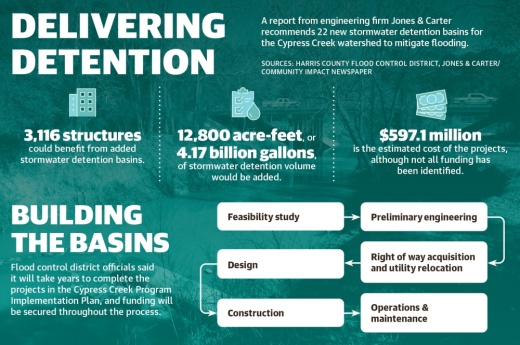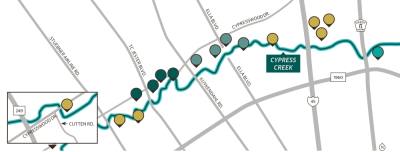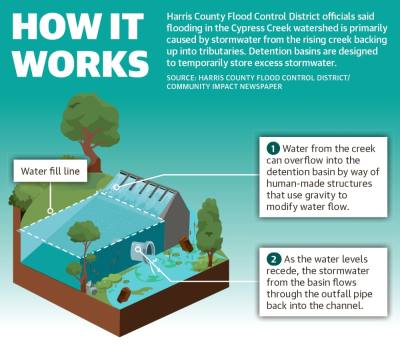“With the Tax Day flood, we dodged a bullet,” he said. “But with Hurricane Harvey, we got 4 feet of water in our house. Our total losses were $450,000.”
Wanting to advocate for the thousands of Spring-area residents who experience repeated flooding, Adamek got involved with the Lakes of Cypress Forest Homeowners Association shortly after moving into the neighborhood. He was later named the organization’s president and created a flood committee, for which he serves as the chair.
“We’re trying to not only point out the issues that we have, ... but also come up with solutions so that [the] Harris County Flood Control [District] can implement [those solutions] or do something to help the residents and the businesses because we’re going to flood again—I mean, it goes without saying,” he said.
Adamek and thousands of other Spring-area residents could soon find relief from flooding once a new plan for the watershed is implemented.
In July 2020, Harris County Commissioners Court approved a $1.4 million agreement for engineering firm Jones & Carter to develop the Cypress Creek Program Implementation Plan, which was released in January and recommended nearly two dozen stormwater detention basins be added to the Cypress Creek watershed. These recommendations would help reduce flood risks for more than 3,000 structures between Hwy. 290 and the Hardy Toll Road over the next several years, according to the report. The projects are expected to cost $597.1 million, and flood control district officials are working to identify funding sources.
If these proposed basins are all added, engineering officials in the report estimate 39% of structures would be removed from the 10-year flood plain; 21% would be removed from the 50-year flood plain; and 19% would be removed from the 100-year flood plain. Structures in these flood plains have a 10%, 2% and 1% chance of flooding in any given year, respectively.
Since Harvey, the HCFCD has completed or initiated several mitigation projects and studies. More than $291 million of the $2.5 billion flood bond Harris County voters approved in 2018 was set aside for Cypress Creek projects, including home buyouts, maintenance work to restore channel conveyance capacity, storm debris removal, drainage infrastructure repairs and detention basins.
Jonathan St. Romain, a department manager with the HCFCD, said stormwater detention basins are more effective than channel modifications. Detention basins temporarily store stormwater until it can make its way back into a nearby channel. Most of the projects would be multipurpose.
“We understand that communities need and desire these projects as well that allow for flood risk reduction, while at the same time, you know, it sort of is common sense that you can look at a detention basin that is this open area of land that is ... good and useful to put trails around and to provide pockets of parks and other features,” St. Romain said.
Basin basics
The Cypress Creek Program Implementation Plan evaluated 49 potential stormwater detention basin sites before narrowing the list down to 23 basins distributed throughout 11 areas along Cypress Creek.
Factors weighed in the prioritization process included flood risk reduction, existing condition, project efficiency, social vulnerability index, partnership funding, long-term maintenance costs, environmental effects and the potential for multiple benefits, according to the report.
Spring-area projects in the top-priority tier include a group of four basins near the intersection of Cypresswood Drive and TC Jester Boulevard as well as a group of three basins located along Cypress Creek between Kuykendahl Road and Ella Boulevard—all of which are slated for construction in 2024, pending funding.
Additional top-priority basins include one proposed for construction in 2025 near Cypress Creek and Ella Boulevard and another proposed for construction in 2026 near FM 1960 and the Hardy Toll Road, according to the report. Combined, these projects would remove more than 637 structures from the 100-year flood plain at a cost of roughly $174.7 million.
Ultimately, 22 of the 23 sites were recommended in the prioritization process, including 16 in the Spring area. According to the report, these basins combined would hold about 12,800 acre-feet—or 4.17 billion gallons—of excess stormwater.
Michael Baker International’s Cypress Creek Watershed Major Tributaries Regional Drainage Plan update from February 2020 recommended about 26,500 acre-feet of stormwater detention be added to the watershed, which would be enough space to store 8.6 billion gallons of water. An additional 30,000 acre-feet, or nearly 9.8 billion gallons of water, is recommended upstream in the Little Cypress Creek subwatershed.
St. Romain said while adding 56,500 acre-feet of detention is feasible, it would take years to achieve.
“That’s really the reason we have this plan is to have a long-term road map so that we can get there, but everybody—us included—we’ve got to understand that kind of scale can’t happen quickly,” he said.
Mitigation efforts
Jim Robertson, who serves on the board of directors for the Cypress Creek Flood Control Coalition, was pleased to see a prioritized list where detention basins could be located—a first for the watershed, he said.
However, Paul Eschenfelder, the founder of Cypress Creek Association—Stop the Flooding, criticized that the plan would only remove 19% of structures from the 100-year flood plain at an expense of nearly $600 million.
“In the end, that’s going to leave over 13,000 structures and $15 billion in economic value exposed to repeated flooding,” Eschenfelder said. “If you flood these [structures] repeatedly, are they going to be worth $15 billion? No. People are going to move away. ... We’ll see the Cypresswood area become the next [FM] 1960 because we have not addressed the infrastructure. We believe this is just a disastrous plan for the Cypress Creek community.”
Eric Heppen, who works on the technical staff for Harris County Precinct 3 Commissioner Tom Ramsey, said while getting structures out of the 100-year flood plain is critical, the commissioner’s approach to flood mitigation is to act now and help as many residents as possible.
“Residents want to know, ‘For that two-year storm, that 10-year storm that truly happens more frequently, am I protected?’ We do try to do the most that we can to get the best benefits to the taxpayers,” he said.
As of the 2020 census, more than 450,000 individuals live in the Cypress Creek watershed, and another 45,000 live in the subwatershed of Little Cypress Creek, according to the HCFCD. The population has grown by 31% and 57%, respectively, in the past decade.
St. Romain noted the watershed is highly developed and historically prone to flooding.
Heppen said he believes new development is not contributing to higher flood risks because developers are now required to meet stricter regulations. This means neighborhoods developed in the 1960s, 1970s and 1980s—such as Champion Forest, Westador, Ponderosa Forest and Wimbledon Champions—tend to be more prone to flooding.
“Even if development continues, they’re developing much more responsibly. ... Developers have learned that they can build even more detention [than what is] required, and it tends to be an amenity towards their development,” Heppen said.
Next steps
Several basins in the top-priority tier are underway in the Spring area. The HCFCD is seeking funding partners throughout the development of the 22 basin projects, and the district is working to acquire properties it does not already own, St. Romain said.
Once these are developed, St. Romain said the district could revisit the original list of 49 sites.
Adamek said he is hopeful the upcoming change in precinct leadership—slated to occur in late March as a result of redistricting—may be a turning point for residents and businesses along Cypress Creek.
“Tom Ramsey seems to be very interested in what our issues are in Cypress Creek and wanting to know how he can help, so we’re at least positively inclined that with an engineer like Tom Ramsey [as our commissioner], we might get some help,” Adamek said. “But we are pretty helpless. So [when] we get into hurricane season, you’re going to see people on Cypress Creek flood if you’ve got a hurricane dumping water on the watershed from Waller County to I-45.”








